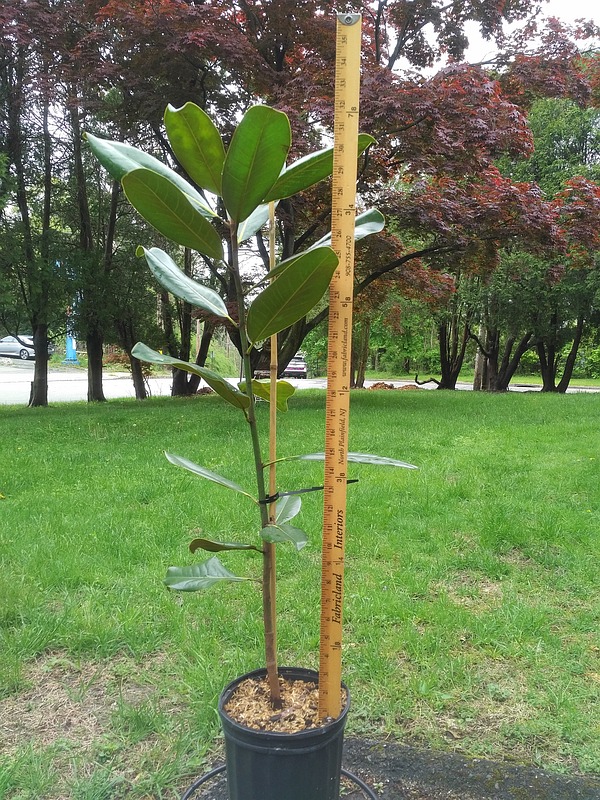



Source: Rare Find Nursery (NJ)
Size shipped: #1 pot (measured 2'8")
Planted:
First flowering: None yet
I wasn't expecting a young southern magnolia to have leaves so big that it looked like a houseplant... but there we are.
When it finally started growing at the beginning of June (I noted that it didn't seem to be visibly shocked), this magnolia's internodes were ridiculously short, creating a month's worth of very dense foliage right up at the top of the trunk. I'm not sure if the hotter weather or me switching from Dr. Earth Pure Gold (1-1-1) to Dyna-Gro Foliage-Pro (9-3-6) was responsible for what followed, but in early July, all of this suddenly changed and the growth became much more vigorous -- and branching. Edith ended up putting on about 1' of new growth in 2019.
In early August 2019, I accidentally nudged off the trunk's terminal bud; it came off so easily that I wonder if it was already almost dead anyway. So now the terminal buds on the four or five branches are the only active buds left (none of the older axillary buds have been activated), and we'll see if one of them becomes a dominant leader. I didn't exactly want the trunk to stop at only 3 feet tall, but it happened.
In late March 2020 (possible due to the unusually warm winter), I planted out Edith in the yard where it can enjoy a full sun exposure. I was pleased to see that the Rootmaker pot appeared to have done its job -- there were plenty of roots at the periphery of the root ball, and none of them were circling the pot or in danger of girdling the trunk. However, some strong winds had it tilting dangerously, so I added stakes low on the trunk to prevent tearing the roots while still allowing the top to move (which strengthens the trunk).
In May 2020, this evergreen magnolia slowly dropped all but the very newest 8-9 or so of its leaves -- including some which had just grown in 2019, which was the truly worrying part -- and I will never know whether that was to be expected for that time of year or whether it was due to my failure to water it that one week when we kept getting forecast rain that never actually happened. But the remaining leaves continued to look fine. It would appear that not growing until June is just its natural timing, as the buds didn't finally swell noticeably and start splitting at the tips until the first week of June when the weather got much more summery, viz. highs in the 80s and chance of rain and thunder every single afternoon. Just needed to make it feel like home in the Deep South, I guess? Even the crapemyrtles started sooner; the only other plants I have that still haven't started growing noticeably by the beginning of June are the conifers and the Prague viburnum. And it's clearly not a general broadleaf evergreen thing, because the hollies got started earlier.
Early July 2020, unlike early July 2019, saw no growth from Edith, a break that would continue through the first half of August. Perhaps the unusually hot and dry June/July had something to do with it? Or just residual transplant stress and not enough leaves to rebuild the starch reserves any faster than that? However, despite the surprisingly slow growth, one thing for which this magnolia deserves recognition is its being completely unaffected by the deer that came through and ate a number of my other plants in November-December 2020 -- confirming the deer tolerance ascribed to it by Dove and Woolridge. And I should note that, as much as I love the plants I've gotten from Rare Find, they were totally wrong on this point: they don't give any of their southern magnolia cultivars the "deer resistant" icon, but they DO give it to the one plant of mine that has suffered THE MOST from deer out of any I have bought, namely, the Olympic Fire mountain laurel.
...And then in early January 2021, Edith taught me, in the most crushing way possible, that browsing foliage isn't the only thing I have to worry about the local deer doing.